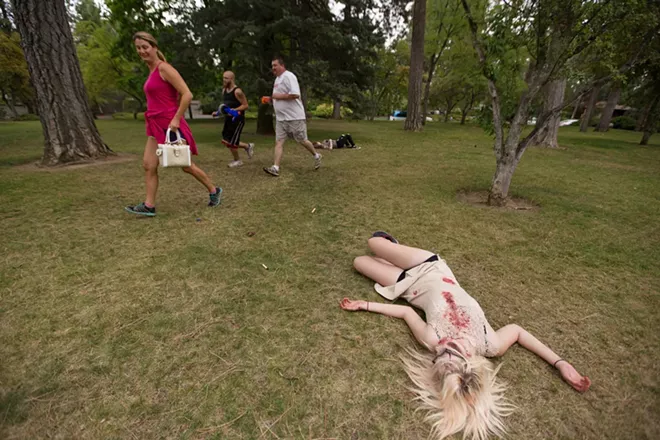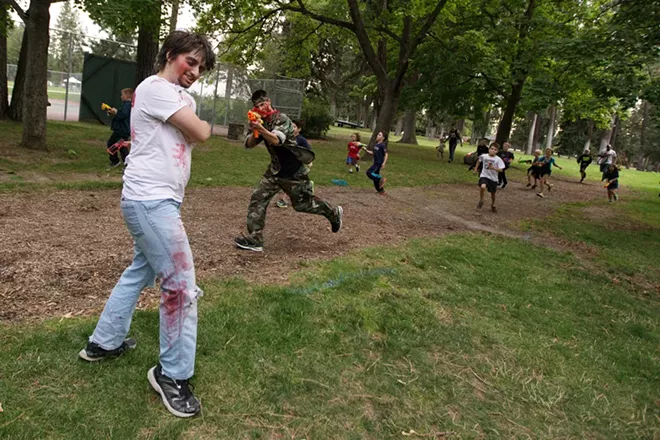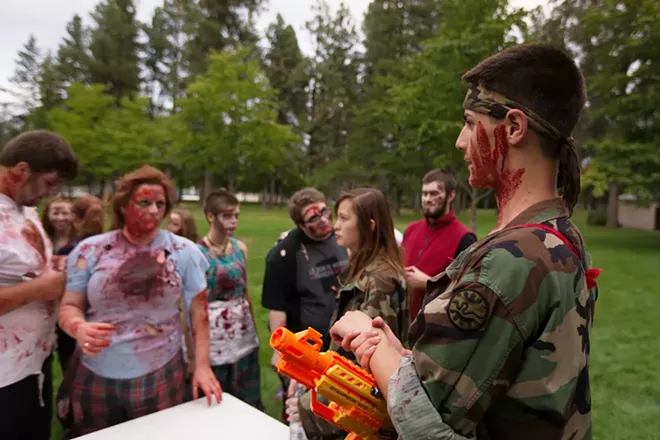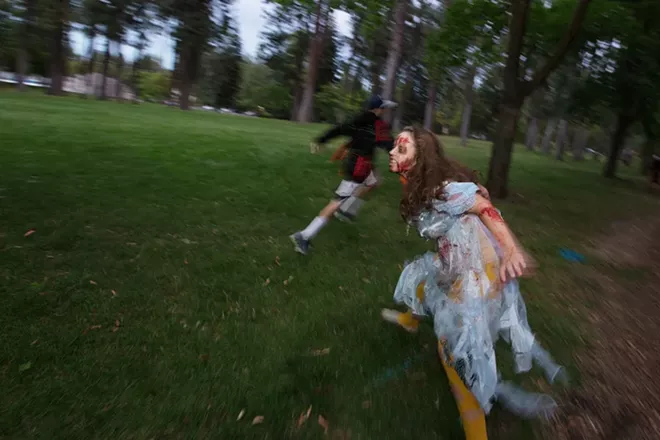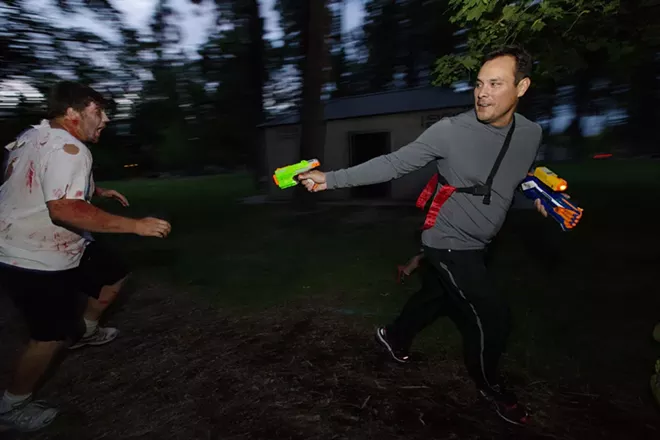Sunday, August 31, 2014

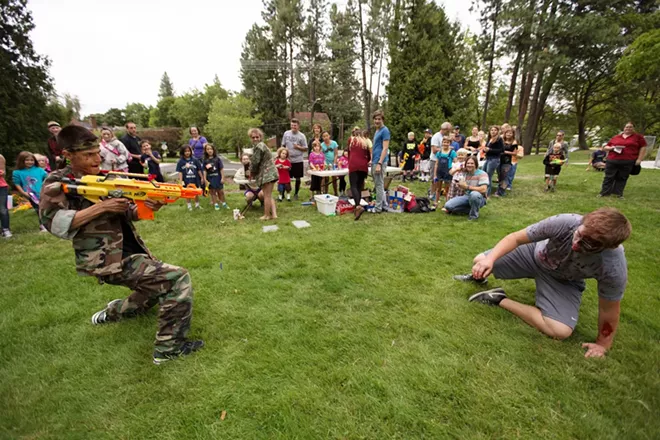

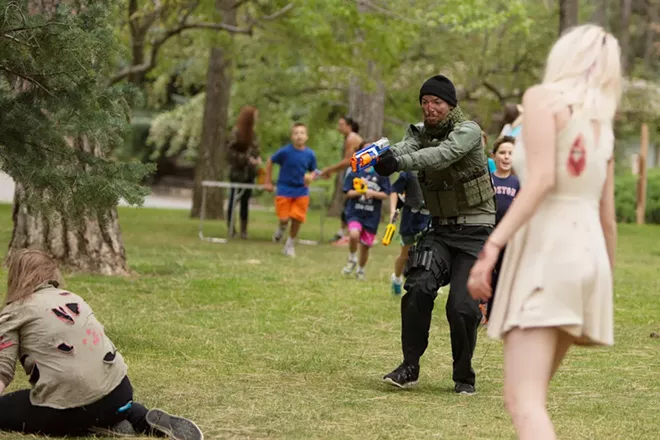


Tags: photos , zombie , zombie run , comstock park , spokane , washington , wa , Culture , For Fun! , Arts & Culture , Image
Friday, August 29, 2014
A Pierce County judge ruled this afternoon that nothing in state law — including Initiative 502, which legalized recreational marijuana — prevents a city from enacting a local ban on pot businesses, report the Associated Press and Seattle Times.
As Washington has implemented its marijuana law, the debate over whether cities and counties should be able to pass local moratoriums on the businesses has been ongoing. The state attorney general has said he believes there's nothing in the law preventing such bans. Supporters of the law (like the hopeful entrepreneur looking to open a pot store in Fife) have argued local bans undermine the voters' will in approving I-502 and the goal of eradicating the black market. A similar case is ongoing in Wenatchee.
The other big argument in this case was about whether federal law preempts state law. If so, state-level legalization could be doomed. Yet, even while he upheld Fife's ban, the judge in this case reportedly said he saw no evidence that the federal Controlled Substances Act prevents states like Washington from making their own drug laws.
Read more from the Associated Press here.
Tags: marijuana , fife , pierce county , i-502 , News , Image
FRIDAY
Yes, YG postponed his Knitting Factory show. A Twitter post from this morning lent some explanation: “Spokane. The show today got pu$hed back. Due to all this f—-in work I gott goin on.” We wrote about him in this week’s issue.
As Inlander contributor Gawain Fadeley points out: together PANGEA have hit the pavement hard in 2014, touring in support of their awesomely named full-length, Badillac. This is a band unafraid of solos, but they’ve retained the knack for hooks that made their previous records stand out. Friday’s Bartlett performance will be the first of two area shows for the band in the coming months — watch for them when the Burger Records Caravan rolls through in October. The all-ages show, featuring Normal Babies and Meat Market, starts at 8 pm and is $10.
SATURDAY
Local rockers Pine League have two shows Saturday tonight. They have the Mootsy’s gig with Estafets (starts at 9 pm and is $5), and then also the Bartlett show with the Blakes and the Camaros (the all-ages show starts at 8 pm and is $5). You could follow 'em around to both, or just hit up one.
THROUGH MONDAY
The one and only Pig Out in the Park continues through Monday featuring local and national acts Check out our music schedule ideas for you here. See the awesome food options here.
See our music calendar here for full listings.
Tags: This weekend in music , pig out in the Park , YG , Spokane music , local music , Music , Image , Video
BlueStar Technologies, Erick Hansen’s Blu-ray company dogged by accusations of fraud and poor management, has been evicted from Spokane’s Commercial Building. According to one former BlueStar employee, the business is no more.

When we published “Wizard of Spokane” in February, one of the most surprising things was that BlueStar Digital Technologies was still running in Spokane, despite an FBI investigation, multiple lawsuits and massive amounts of debt.
In fact, in an email responding to the story at the end of February, BlueStar engineer Allen Pabst expressed enthusiasm for the company’s prospects: “By the way, I have received now several orders and we are running well now. The new sales team is great! I am even using local suppliers to supply many of our production material needs and this is working great. I would love to show you again but the attorney said no for the time being.”
But as with nearly everything that ever that happened to BlueStar, the reality didn’t live up to the hype.
“BlueStar closed in March and no longer exists,” Pabst wrote in an email yesterday. The Nevada Secretary of State, however, still lists the company as officially “active,” showing Hansen filed his annual list of officers on July 15, using incorporation service InCorp as his address.
Dan Olson, owner of the Commercial Building where BlueStar resided, says the company was evicted from his building in April. Olson, reached on the phone yesterday, did not elaborate on why.
Olson is similarly terse when asked for a general comment on BlueStar itself. “I have lots of thoughts on that and lots of comments, but I don’t have any to share,” he says.
Chris Bell, the NAI Black real estate agent who’s listed the Commercial Building property for $2.29 million, says Olson has “been in the process of clearing out the furniture fixtures and equipment and auctioning that off — the specialized Blu-ray equipment.”
“Basically, they defaulted on their lease, and [Olson] terminated their lease and removed them,” Bell says about BlueStar.
He says there’s been considerable interest in the property. But the challenge is the West First neighborhood, where nearby buildings like the Otis hotel remain boarded up and vacant.
“The problem I have is that this is the nicest building on the block,” Bell says.
He says he's had preliminary discussions with Dave Steele, part of the city’s Asset Management Group, about the City of Spokane’s real estate needs. Bell's talked with developers, investors and, he says, at least one nonprofit involved in community services, transitional housing and job training.
“It’s a perfect building for a nonprofit to acquire, occupy the office space on the first floor, then run a commercial kitchen or restaurant,” Bell says.
The upstairs, Bell says, could become a nonprofit-driven low-income housing, just like it was before the tenants were evicted for Hansen’s company back in 2007. Low-income tenants could stay in the apartments upstairs, and then work at the commercial kitchen downstairs.
“It’s amazing how everything comes around full circle,” Bell says.
Tags: Business; BlueStar; Erick Hansen , News , Image
Downtown Spokane parking may just become a bit more relaxed next month as the City Council will consider increasing the time vehicles are allowed to park continuously from 12 to 24 hours. (S-R)
WSU and the Spokane Police force made CNN yesterday on a segment that highlighted local research into how law enforcement officers decide when to use deadly force. (INLANDER)
Nearly all of the people who were leasing 60 state endowment-owned Priest Lake lakefront cabin sites won in bidding yesterday. (CdA Press)
THERE
What a sweetheart. Russian President Vladimir Putin has called on pro-Russian separatists to release trapped Ukrainian soldiers, just one day after his country rolled into Ukraine. (WaPo)
Yesterday, President Obama wore a tan suit to a press conference … before Labor Day. Twitter exploded over the injustice. (CNN)
California is poised to pass a bill that would turn its college rape policy from “no means no” to “yes means yes.” (SJ Mercury)
More than 1,200 illegal and incredibly damaging giant African snails have been seized by the USDA. (ST)
HAPPY FRIDAY
It's almost Labor Day Weekend! Check out all of the awesome local events right here. (Inlander)
Tags: Morning briefing , giant snail , yes means yes , parking , Priest Lake , News , Image
Thursday, August 28, 2014

OUTLANDER serves as a weekly (at least) round up of Inland Northwest outdoor recreation and natural resources news. This feature will highlight a wide variety of issues and events, ranging from camping stories to national environmental disputes. We’ll also try to include some scenic photos. Feel free to pass along suggestions or curiosities. Read previous Outlander posts here.
—-
State parks officials announced this week that potable water at Palouse Falls State Park (pictured above) will be shut off for the rest of the season due to concerns about contamination. Park remains open, but bring your own drinking water. (State Parks)
Wildlife officials hunting from a helicopter shot and killed one member of the Huckleberry wolf pack in Stevens County. At least 22 sheep kills have been tied to area wolves. Conservationists have called for increased nonlethal efforts while ranchers have defended the right to graze in the area. (WDFW/Conservation NW/S-R)
Meanwhile, Idaho wildlife officials would ask the public to report any wolf sightings in the state to help biologist track activity. Take note of color, size, behavior or other details. (IDFG)
Washington state officials this afternoon also released new hunting prospects for specific county areas with recommendations for successful outings. (WDFW)
Recent updates on the long-term impact of the Carlton Complex fire in Central Washington — from new mudslide damage to future housing struggles. (Inlander/Al Jazeera America)
Local environmentalists and water quality advocates gathered this week for a totem pole journey to voice oil train safety concerns. (Spokane Riverkeeper)
With one last blast, the Glines Canyon Dam, the largest dam to ever be removed, came down this week, restoring the unencumbered flow of the Elwha River through the Olympic Peninsula in western Washington. (National Geographic). Watch the explosion. (ElwhaFilm.com)
State health officials released new guidelines for hunters on handling big game meat to avoid disease. (DOH)
The wild story of a man living in the woods of central Maine for nearly 30 years without human contact. (GQ)
Petzl climbing gear’s technical director hosted an AMA on Reddit earlier this week with lots of technical jargon like: “A locked, tri-loaded carabiner usually falls around 30-50% of its major axis rating.” So if that gets your motor going, check it out. (Reddit)
Friends of Scotchman Peaks Wilderness also announced the reopening of historic Star Peak Trail No. 999 after months of trail rebuilding. The group also offers a variety of guided hikes this fall. (Scotchmanpeaks.org)
And we’re on Twitter now. Check out it out for bite-sized updates throughout the week.
For four years, Doctor Who has been pure fan fiction.
That’s not a pejorative, it’s simply an accurate description: The show’s current showrunner, Steven Moffat, was once a little chubby curly-haired kid watching the old Doctor Who series and reading Doctor Who paperbacks.
And, in a fairy-tale happy ending, that little boy grew up and took reins of the show he loved so much.
Doctor Who, if you haven’t heard, is a show about a zany British-accented Time Lord, who takes his “companions” (usually an attractive female) on all sorts of adventures. Moffat, a writer on the show (and writer of the Emmy Award-winning Sherlock) replaced Russell T. Davies as Doctor Who’s head showrunner in 2010. Most people were excited. After all, Moffat had written some of the show’s best episodes.
But in the last few years, Moffat’s come under fire for what they see as a decline of Doctor Who. Critics say he’s sexist, that he’s too obsessed with puzzle-box plotting, that he hits his themes too often, that he’s made the show too big and too messy.
Taken individually, many of the points they make are good ones, but in trying to say that Moffat has hurt the show as a whole, they seem to forget how many awful moments there were during the Davies era. The worst, worst, worst of Doctor Who came under Davies: The two-parter with the farting aliens? Written by Davies. The terrible episode that ends with the implication of a character getting oral sex from a paving stone? Written by Davies. And while he didn’t write it, he pushed the main plot-points for “Fear Her,” the cringe-worthy episode with drawings that come alive.
Moffat’s seasons have been uneven, sure: But never so bad as Davies’ worst moments.
By contrast, nearly every great episode from the Davies era was written by Moffat. He was the one coming up with all the best ideas: Carnivorous shadows. Stone angels that murder by touch, but only move when you blink. A medical nanobot swarm that re-forms human faces into the visages of gas masks. In fact, sometimes Moffat’s weakness is too many good ideas. He tries to shove a dozen sci-fi concepts into single episodes and crowds out the impact of any of them. Even when Moffat became showrunner, he delivered, by far, the best Christmas serial of the modern era, using time-travel as an elegant way to deconstruct and reimagine Dickens’ A Christmas Carol. Even the weakest episodes of his tenure have had great moments.
Look at this beautiful monologue, where The Doctor tells off a God the size of a sun, or this one, where he sums up the whole show by unreeling the scope and danger of the universe to a beleaguered dad. Both are from mediocre episodes (written by other writers during Moffat’s run) but they contain some of my favorite scenes.
Frankly, Moffat is just more creative. Davies relied on pure unimaginative scale to create stakes in his season finales, flooding Earth with a thousand Daleks or a million Cybermen, or a million Toclafane. Davies created impossible situations then easily resolved them with a magical button press, a flurry of techno-babble, or the gauzy power of love.
Moffat, for the most part, went a far more complicated route: He plants the seeds of the villains’ defeats in his finales far before he even faces them. The success of this tactic has been uneven, but it’s far more ambitious and fascinating than anything his predecessor attempted. Even the chaos and frantic nature of the show feel like they reflect the character of the show’s central figure.
Doctor Who is a show about the wonder and terror of time as well the wonder and terror of space. Moffat understands that, using time travel as a tool to explore the horror of old age and loneliness, to examine the redemptive power, not of love, but of memory. That’s a rabbit hole worthy of exploring.
One accusation does seem valid: His major female characters — River Song, Amy Pond, Clara Oswald — all feel cut from the same cloth. Remove the actresses performances from the equation and the writing for them often feels identical.
But Moffat’s writing of his companions, flirtatious and prone to sexually-charged banter, seem far less sexist than Davies’ writing of Rose Tyler, the companion who spent much of her time desperately mooning over the doctor. Some critics have accused Moffat’s female characters of too often playing damsels in distress. But Pond is much more assertive and foregrounded than her husband. Both Pond and her husband are damsels in distress at times, yet both get to be the shiny-armored knights riding to the other’s rescue.
Moffat is an uneven writer, sure. But Doctor Who has always been a wonderfully uneven show, all the way back in the days of black-and-white monsters with visible zippers.
Tags: Doctor Who , BBC , TV , Image

If you're looking for a head start on the weekend, this Thursday is filled with opportunities to see some live music.
Pig Out in the Park
From noon until 9:45 pm, three different stages will feature artists among the aroma of tasty food at Riverfront Park. This free event continues through Monday, but don't wait for the weekend to start piggin' out, see our music suggestions here.
G Eazy
California rapper G Eazy will play with IAMSU!, SOL and J Ant tonight at the Knitting Factory. These artists have sold out the all ages venue, bringing a diverse hip hop scene to downtown Spokane.
Supersuckers
The Hop! will host this Seattle rock 'n' roll band at 8 pm for $12. Brash and hard, these guys will tell you just like it is, and do so loudly.
Muscle and Marrow
Ambient and dark sounds will come from Moosty's during the Muscle and Marrow show. Hailing from Portland, this duo prides itself in blending unusual genres and haunting us in the process.
She Keeps Bees
Tonight, Jones Radiator plays host to the bare beauty of this blues rock duo. Vocalist Jessica Larrabee's emotional voice will seduce and mesmerize you. The show is free and starts at 7 pm.
Check out this new video See Keeps Bees posted for a track off their upcoming album!
Tags: Local music , Pig Out in the Park , She Keeps Bees , Supersuckers , Music , Image , Video
Local research into how law enforcement officers decide when to use or not use deadly force made a CNN segment today, featuring footage of Spokane Police Department officers wired for testing at Washington State University.
WSU professor Bryan Vila explains in the segment that despite extensive police training, researchers still have little understanding of how that effects split-second decision making on the street.
“We still don’t know if there’s a connection between the training we give police officers and their performance in a combat situation,” he says.
The segment shows SPD officers hooked to brain and heart monitors as they engage suspects on interactive video screens. Some preliminary research has indicated that officers often perceive minorities as more threatening, but also appear to “overcompensate” with a reduced tendency to use force.
“Sometimes we don’t know if we made the right decision or the wrong decision,” SPD Sgt. Terry Preuninger says in the segment. “We make a decision and then we live with it for the rest of our lives.”
CNN’s Anderson Cooper also hosted a brief discussion of how such issues play into the recent unrest in Ferguson.
In a recent story, the Inlander explored some of the factors and justifications Spokane County Sheriff’s deputies considered prior to fatally shooting a distraught man armed with multiple firearms in February.
SPD spokeswoman Monique Cotton notes the WSU research has also included work on de-escalation efforts and the introduction of Crisis Intervention Team training for engaging people with mental health issues.
Tags: Spokane Police Department , Washington State University , CNN , News , Image , Video
As all of us look to make the most of the last days of summer, here at the Inlander we're already thinking months ahead into the fall and winter. Work on the annual Fall Arts Preview issue, out on Sept. 18, is in full swing. If you are involved with a local arts organization — a theater, gallery, performance group or any other arts-related endeavor — here's what you need to know to get your events included in that issue's massive, 14-page calendar listing events from mid-September through the end of the year.
Important dates: The deadline to submit arts events for the Fall Arts calendar is Thursday, Sept. 4, by 5 pm. However, early submissions are always appreciated. The calendar timeline is Sept. 18-Dec. 31.
Events that qualify for listing: Because this is an arts-focused issue, we are mainly looking for events that fit into general categories of theater, visual arts, words (poetry, author readings, lectures, etc), film, cultural events, comedy and music, both classical and non-classical.
What to submit: The basics — event name, date(s) and time, cost, contact information (a website and/or phone number for readers to find more information) and a brief description of the event. You can also submit any images that directly pertain to the event (photos from past years or event posters are always great. Please don't send stock photos or logos.).
How to submit: With our new-ish website that launched almost a year ago, users can directly submit their events to us online at inlander.com/getlisted. This method is our preferred way to receive events because it ensures that users aren't missing any critical pieces of information, and it also let's us get your events up online faster than any other submission method. The Listings Editor (me) typically logs in daily to edit and approve user-submitted events.
The second method is to email your fall schedules to getlisted@inlander.com. Make sure to include the details listed above, and to send your events before or by Sept. 4. That's a week from today!
Please direct any questions about the Fall Arts Preview calendar to Chey Scott at cheys@inlander.com. I look forward to compiling all your events so the community knows what to look forward to this fall.
Tags: Fall Arts Preview , event listings , Arts , Culture , Arts & Culture , Image


